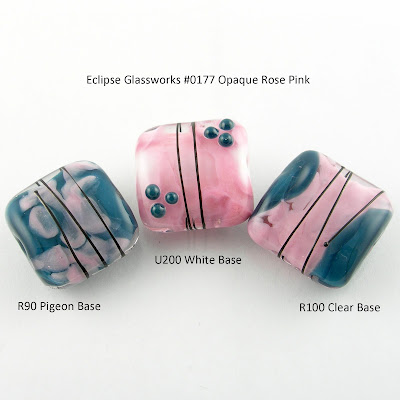Eclipse Glassworks Color Testing
#0177 Rose Pink
Personally, I would rename this color to bubblegum or cotton candy because it is YUMMY!I'll be honest, I started with this glass because it seemed the most unassuming of the sample packets I received. Boy was I surprised when it came out the most scrumptious bubblegum pink after being worked in the flame.
Working Notes
Opacity: This is an opaque glass. When applied heavily over clear, it does not allow too much light to pass through. However, when applied thin - especially over a dark base color, it is semi-translucent and shows the base color. This could also be attributed to the spreading nature.Spread: As with most pink glass I've worked, I would classify this as a spreader. When heated it spread out over the base color. It also attempted to seep out of the encasement layer if I gave it even the slightest opening.
Futz Factor: Opaque pink glass will often devitrify if exposed to repeated heating and cooling. This is handled easily by encasing it with a layer of clear if you intend to marver heavily or press. I found it easily corrected itself when brought back up to a nice warm even glow before popping into the kiln.
It boils easily if overheated. I always forget this when switching between 104 and 96 COE. Most furnace glass is not formulated for work in a sharp hot flame and will boil if you forget to pay attention or try to melt it in too quickly. After scorching the first stringer I pulled, I backed off the heat a bit and worked it slightly further back in the flame and it behaved itself just fine.
It did not create any pitting though - which was nice. After a slight flame adjustment I found it quite easy to work. It is soft, melted nicely, and went on smooth.
Color: YUM. I wouldn't call it a striking glass per se, however, the color definitely developed the more I worked it in the flame. It especially glows a beautiful cool pink when sandwiched between clear - no beige or brown undertones it is a truly bright and beautiful perfect baby pink.
Compatibility: This is a 96 COE furnace glass. Beads were made with a combination of Reichenbach furnace glass cane, Uroboros System 96 cane, and Eclipse Glassworks frit. Fused cabochons made with System 96 and Eclipse Glassworks frit, and a sprinkle of mica powder. Small spree bead made with Effetre 104 clear to test viscosity.
Disclaimer: I am not affiliated with Eclipse Glassworks. I received some sample glass in exchange for an honest review.
See Also: Eclipse Orchid Glass Testing






Comments
Post a Comment